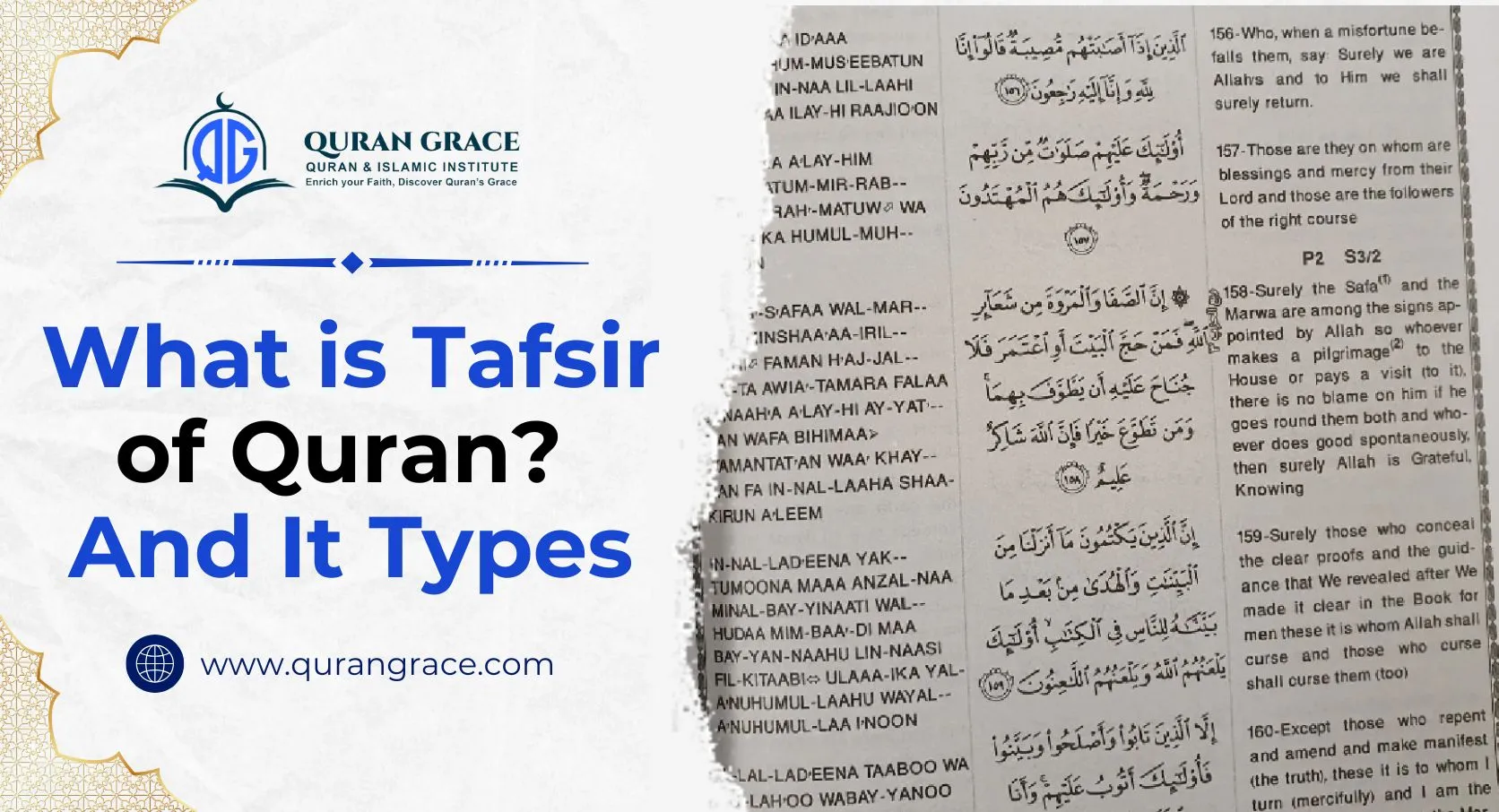Numerous scholars have dedicated their efforts to interpreting the Quran to uncover its meanings, purposes, and rulings. This interpretation is essential as it fosters a deeper understanding of the Quran. In this discussion, we will provide a detailed explanation of what Tafsir is and outline its various types. Those who wish to learn the Quran with proper tafseer and comprehension should be aware of these different types of Tafsir.
Table of Contents
ToggleWhat is the Tafsir of the Quran?
Interpretation is a discipline focused on understanding and explaining the verses of the Quran. It reflects the words of Allah and aligns with the understanding of the Companions RA, as well as the comprehension of the Prophet PBUH. Their grasp of the Arabic language plays a significant role in this understanding; allowing Muslims ample time with the Holy Qur’an to comprehend its meanings is essential for later application in their lives.
Through Tafsir, Muslims can understand the legal rulings present in the verses, which inform them of what Allah has permitted and what He has forbidden; gain insights into the events of the Prophet’s biography; establish the foundations of their faith, including belief in Allah, His angels, His books, His messengers, the Last Day, and Qadar (divine decree), encompassing both good and bad, and learn the stories of the prophets and messengers.
The Origin of the Tafsir of the Quran
The tafseer of the Quran has its roots in the time of the Prophet Muhammad (PBUH). After his passing, his devoted companions took on the crucial task of elucidating the meanings of the Quranic verses. These companions, who had the unique privilege of witnessing the revelation firsthand, understood the context and reasons behind each verse. They drew upon the teachings of the Prophet (PBUH) to share this wisdom with their students.
Among the most notable figures dedicated to this endeavor were
- Abdullah Ibn Abbas (RA)
- Zayd Ibn Thaabit (RA), and
- Ali Ibn Abee Taalib (RA). Their commitment to understanding and explaining the Quran laid a strong foundation for future generations.
As time went on and the companions passed away, their students—known as “the successors”—took up the charge. These successors immersed themselves in the study of the Quran, relying heavily on the rich resources passed down from their mentors. Their interpretations were grounded in three primary sources: the Quran itself, the Sunnah, and the insightful explanations provided by the companions. Through their efforts, the depths of the Quran continue to be illuminated for all who seek guidance.
Types of Quran Tafseer
There are 2 types of Tafseer of Quran
- Tafsir bil-Ma’thur (or Tafsir bir-Riwayah) received interpretation.
- Tafsir bil-Ra’y (or Tafsir bi’d-dirayah) opinion.
1. Tafsir bi’l-Ma’thur (or Tafsir bi’r-Riwayah)
Tafsir bil-Ma’thur refers to the interpretation of the Quran using authoritative sources such as the Quran itself, the Sunnah (sayings of the Prophet Muhammad), the sayings of the Companions (Sahabah), and, according to some scholars, the statements of the Successors (Tabi’een). This method relies on transmitted knowledge and avoids personal opinion unless supported by these sources.
Types of Tafsir bil-Ma’thur:
- Tafsir of the Quran using the Quran: This approach involves interpreting one verse of the Quran by referencing another. For instance, the directive to “fulfill the contracts” (Quran 5:1) can be further explained by another verse that outlines what is prohibited (Quran 5:3).
- Tafsir through the Sunnah: This method relies on the explanations given by the Prophet Muhammad regarding various Quranic verses. A good example is his interpretation of “those who consume usury” (Quran 2:275), which he clarified as involving unfair exchanges of specific goods.
- Tafsir by the Sayings of the Companions and Successors: The insights of the Prophet’s Companions are especially valued due to their closeness to him and their deep understanding of the Arabic language. This form of Tafsir draws on transmitted sources, including the Quran itself, the teachings and actions of the Prophet Muhammad (PBUH), and the interpretations made by his Companions.
Certain Quranic verses, for example, can provide insight into one another by discussing similar topics. When a verse appears ambiguous, consulting other Quranic passages can often provide clarification. Furthermore, the Sunnah and Companions’ interpretations provide additional insight into the verses’ meanings.
2. Tafsir bil-Ra’y (Tafsir Based on Reason)
Tafsir bil-Ra’y refers to the process of interpreting the Quran using rational analysis and intellectual reasoning. This approach is acceptable as long as it adheres to established Islamic principles and does not contradict them. Tafsir bil-Ra’y requires a thorough understanding of the Arabic language, Islamic jurisprudence, and various related sciences to ensure that interpretations are both insightful and rooted in Islamic theology.
Conditions for Tafsir bil-Ra’y:
- An interpreter should hold strong beliefs and have genuine intentions.
- They need to be proficient in Arabic, knowledgeable about Quranic sciences, and well-versed in Islamic jurisprudence.
- They need to stay clear of personal biases, philosophical deviations, and unverified narratives.
An example of Tafsir bil-Ra’y is the interpretation of “Whoever desires the life of this world” (Quran 17:18) as referring to both believers and non-believers, with the latter being the primary focus due to the subsequent mention of punishment in the Hereafter.
This type of Tafsir is based on reasoning and Ijtihad (independent scholarly work), rather than direct transmission. Scholars use comparison and contrast between Quranic verses, traditions, and Companions’ sayings to derive interpretations. This method does not rely on random assumptions, but rather on rigorous analysis to arrive at a specific meaning.
3. Tafsir bil-Lughah (Linguistic Tafsir)
Tafsir bil-Lughah focuses on explaining the Quran using Arabic language rules and nuances. Given that the Quran was revealed in Arabic, understanding its linguistic context is critical for accurate interpretation.
An example is the interpretation of the word “istawa” (ascended) in “Then He ascended the Throne” (Quran 7:54), which is understood metaphorically as a demonstration of Allah’s majesty and authority.
4. Tafsir al-Ishtiraki (Symbolic Tafsir)
Tafsir al-Ishtiraki interprets Quranic verses using hidden or symbolic meanings, which are often associated with Sufi traditions. However, many scholars consider this method to be controversial and invalid because it may deviate from the apparent meanings of the Quran.
For instance, interpreting “Pharaoh” as representing the human ego or “the disbelievers” as internal struggles is seen as an overreach and a distortion of the Quran’s intended message.
5. Tafsir al-Ahkam (Tafsir of Legal Rulings)
Tafsir al-Ahkam focuses on verses about Islamic jurisprudence (Fiqh). This type of tafseeris essential for determining legal rulings and comprehending the Quran’s instructions on worship, transactions, and social behavior.
An example is the interpretation of the verse on ablution (Quran 5:6), where scholars reconcile different readings (e.g., “wash your feet” vs. “wipe your feet”) to establish the ruling of washing the feet during ablution.
Conclusion
Learning the exegesis of the Quran is simple and enjoyable. Once you enroll in the online Tafseer course and start understanding the verses of Allah, you will note the types of Tafseer while reading. Join a free evaluation session today at Quran Grace and begin your Quranic understanding today!








